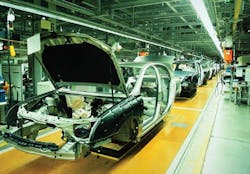About the author: Mike Bjorkman is vice president of BJM Corp. Bjorkman can be reached at 860.399.5937.
The U.S. is the fourth-largest producer of motor vehicles, and, according to the Federal Highway Administration, it also is the largest sales market for passenger vehicles. Having manufactured approximately 2.9 million cars in 2011, U.S. production has grown significantly to more than 4.5 million cars in 2013. This growth is a direct result of automobile makers creating new manufacturing plants in the U.S.
An engineering firm with offices in Europe and the U.S. contacted BPH Pump & Equipment Inc., a full-service distributor of industrial pumps, in the spring of 2010. The engineering firm was working with a European automobile manufacturer that was building a new assembly plant in the U.S. Because the engineering firm had worked with BPH in the past, it contacted the company for assistance. BPH was asked to source submersible pumps that would operate in the new automotive assembly plant’s wastewater sump pits.
The engineering firm explained to Leroy Finnigan, director of engineering for BPH Pump & Equipment, that the new automotive assembly plant would require 10 submersible pumps. Each submersible pump would operate inside of its own individual wastewater sump pit. With 10 separate wastewater sump pits, each submersible pump would have to be controlled by 10 separate control panels. Each submersible pump needed to be able to pump approximately 150 gpm with about 45 to 50 ft of head. Finnigan was asked to recommend submersible pumps that would meet the following critical requirements:
- Durable metallurgy. Like most manufacturing facilities, the new plant would utilize a wash down hose to clean the assembly floor. The wash down hose would spray water containing light-duty chemicals for cleaning purposes. These light-duty chemicals in the water could cause corrosive damage to a submersible pump with cast iron components. For this reason, the submersible pumps selected needed to be comprised of components manufactured from a more durable metal.
- Shredding capabilities. All 10 wastewater sump pits at the new automotive assembly plant would contain wastewater saturated with metal fines. Metal fines are metal shavings, which are a common byproduct of the manufacturing process. Because these metal pieces could be quite large—up to 3 or 4 in. in size—it was critical that the submersible pumps would have the capacity to shred the metal fines so the pits could avoid getting clogged and the wastewater could be pumped.
- Reliability. A significant consideration for the automotive assembly plant was to make sure these submersible pumps were rated for continuous duty. Continuous duty-rated submersible pumps would be required so the plant could keep the wastewater sump pits operating efficiently.
After consideration, Finnigan recommended a model from the BJM SKX submersible shredder pump line for the new automotive plant’s wastewater sump pits.
The new assembly plant needed submersible pumps to operate in individual wastewater sump pits.
Corrosion Control
All wear and “wet” parts of the SKX submersible shredder pump, such as the impeller, wear-plate, oil housing, pump housing and inner pump top are made of Cast 316 stainless steel. Because all parts exposed to the pumped liquids are made of 316 stainless steel, the light-duty chemicals in the wastewater would not cause corrosive damage to the internal components.
The cable entry sealing system is designed to utilize an FKM compression fitting with a stainless steel gland nut to hold and seal the cable. This pump also features individually isolated and potted power leads to prevent wicking.
The seal minder cable and the 33-ft-long standard power cable, which can be customized to any length, are both made of oil-resistant material. Special installation can be made with EPDM power cable and elastomers. The elastomers, such as the lip seals, o-rings and gaskets, are made of FKM.
Built with Class F insulation on the 5-hp pump, the SKX was manufactured with a stainless steel motor housing for corrosion resistance to ensure long life.
Engineered to Shred Solids
The pump was designed for industrial shredding applications.
“These pumps might have to cut pieces of fender that could be up to 4 in. in size,” Finnigan said.
The pump is designed with a Tungsten Carbide Tip Fang impeller that cuts against a “spiral” shaped Hi-Chrome Toothed Diffuser Plate to continuously rip apart solids. With 360-degree shredding action and non-clog, single vane impellers, the pump shreds and passes most solids while delivering high liquid volume.
Reliable Design
The pump offers “Three Seal Motor Protection.” The motor is protected with an oil-lubricated double seal design. The double mechanical seals are comprised of a lower seal made of silicon carbide and upper seal faces made of carbon/ceramic. An additional lip seal is installed above the impeller to help prevent abrasives from entering into the seal chamber.
The motor overload device protects the motor from thermal and amperage overloads. The pump utilizes winding protection and (NEMA) Class F motor insulation, which allows the motor temperature to raise up to 230°F. An automatic switch turns the pump motor off if the temperature and/or amp draw raises too high. When the motor cools, the switch is designed to automatically reset and the pump will once again begin operating.
The pump offers additional protection by way of the Seal Minder Moisture Detection System. The Seal Minder is a sensor probe inside the oil chamber that can provide an early warning to protect the pump motor. When the seal failure circuit, or moisture detection circuit, is properly connected to a control panel, it informs the pump operator that there is moisture within the oil chamber. This early warning can allow the operator to schedule repair and inspection on the pump.
Smooth Operations
Following the approval of the engineering firm, the automobile manufacturer went ahead with Finnigan’s recommendation. A total of 12 pumps were purchased. These 5-hp pumps operate at 460 volts and at 3,450 RPM. While the pumps come with the option of NPT discharge, the automotive plant required pumps with 3-in. ANSI flanges, which would easily adapt to their custom-built slide rail installations.
“The submersible shredder pumps were installed at the new plant in the middle of 2011,” Finnigan said. “Ten of the submersible shredder pumps were installed into the assembly plant’s wastewater sump pits, and two pumps were placed into their inventory to be available as spares—though I am happy to report they haven’t had to use those spares because all the BJM submersible shredder pumps have been running smoothly since startup.”
Reliable pumping systems are at the heart of efficient operations. When designing a new plant, it is critical to install the right pumps for specific applications. Having worked to source reliable pumps, the auto manufacturer has seen success in the four years that its new assembly facility has been operating.

